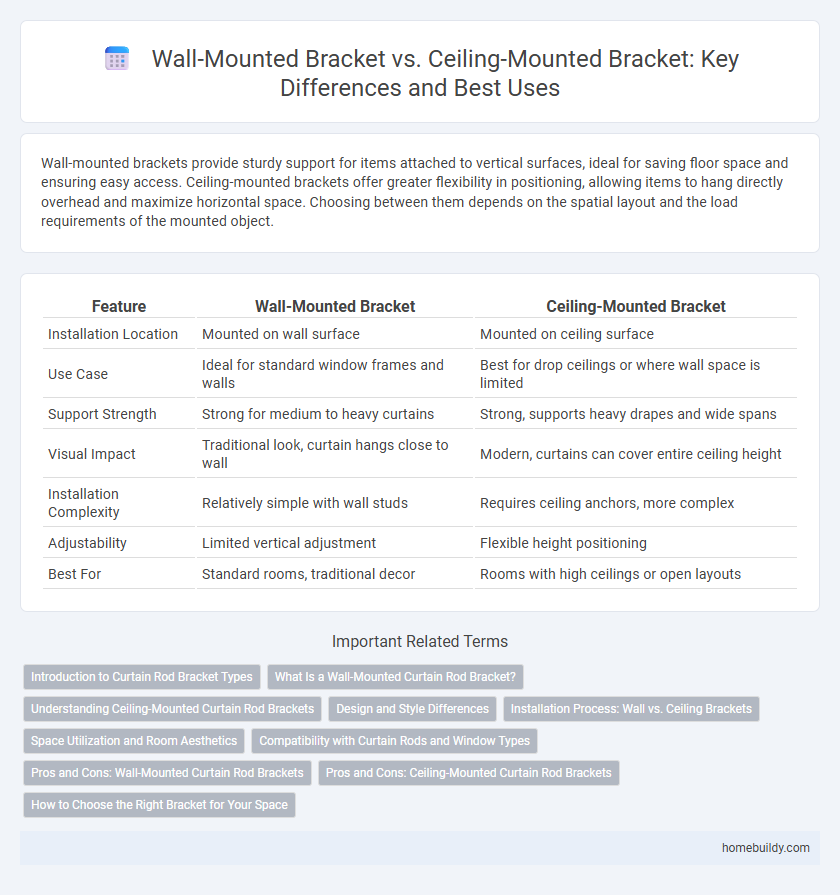Wall-mounted brackets provide sturdy support for items attached to vertical surfaces, ideal for saving floor space and ensuring easy access. Ceiling-mounted brackets offer greater flexibility in positioning, allowing items to hang directly overhead and maximize horizontal space. Choosing between them depends on the spatial layout and the load requirements of the mounted object.
Table of Comparison
| Feature | Wall-Mounted Bracket | Ceiling-Mounted Bracket |
|---|---|---|
| Installation Location | Mounted on wall surface | Mounted on ceiling surface |
| Use Case | Ideal for standard window frames and walls | Best for drop ceilings or where wall space is limited |
| Support Strength | Strong for medium to heavy curtains | Strong, supports heavy drapes and wide spans |
| Visual Impact | Traditional look, curtain hangs close to wall | Modern, curtains can cover entire ceiling height |
| Installation Complexity | Relatively simple with wall studs | Requires ceiling anchors, more complex |
| Adjustability | Limited vertical adjustment | Flexible height positioning |
| Best For | Standard rooms, traditional decor | Rooms with high ceilings or open layouts |
Introduction to Curtain Rod Bracket Types
Wall-mounted brackets are the most common curtain rod supports, attaching directly to the wall and allowing for versatile placement above windows. Ceiling-mounted brackets secure the rod to the ceiling, ideal for rooms with limited wall space or for creating floor-to-ceiling window treatments. Both types offer distinct advantages depending on window size, curtain style, and room configuration.
What Is a Wall-Mounted Curtain Rod Bracket?
A wall-mounted curtain rod bracket securely attaches to vertical wall surfaces, providing stable support for curtain rods and window treatments. Designed for easy installation, these brackets position the rod away from the wall to allow curtains to hang freely without obstruction. Suitable for various wall types, wall-mounted brackets accommodate both decorative and functional curtain styles, ensuring durability and aesthetic appeal.
Understanding Ceiling-Mounted Curtain Rod Brackets
Ceiling-mounted curtain rod brackets provide a sleek solution for hanging curtains in spaces with limited wall space or high windows, supporting rods directly from the ceiling for a clean, modern look. These brackets are ideal for creating the illusion of height, allowing curtains to extend from ceiling to floor, enhancing the room's vertical dimension. When choosing ceiling-mounted brackets, consider the weight capacity and ceiling material to ensure secure installation and optimal curtain support.
Design and Style Differences
Wall-mounted curtain rod brackets offer a classic, versatile design that complements most interior styles, providing sturdy support and easy access for curtain installation. Ceiling-mounted brackets create a sleek, minimalist look ideal for modern or compact spaces, enabling curtains to hang closer to the ceiling for an elongated visual effect. Both types differ significantly in placement and aesthetic impact, influencing room ambiance and curtain functionality.
Installation Process: Wall vs. Ceiling Brackets
Wall-mounted curtain rod brackets require securing directly into wall studs using anchors and screws, ensuring stable support for heavier curtains. Ceiling-mounted brackets involve attaching the hardware to ceiling joists or using toggle bolts for drywall, demanding precise measurements to maintain rod alignment and curtain drop. Both installation types necessitate level positioning and appropriate tools, but wall mounts generally offer easier access and adjustment compared to ceiling mounts.
Space Utilization and Room Aesthetics
Wall-mounted curtain rod brackets optimize space by allowing curtains to hang close to the wall, preserving ceiling height and maintaining an open room feel. Ceiling-mounted brackets create a dramatic, floor-to-ceiling appearance that can make a space feel taller and more expansive, ideal for rooms with high ceilings or limited wall space. Choosing between wall and ceiling brackets significantly influences both spatial efficiency and the overall aesthetic impact of window treatments.
Compatibility with Curtain Rods and Window Types
Wall-mounted brackets are compatible with most standard curtain rods and ideal for windows with sufficient wall space around the frame, offering versatility in height adjustment and easy installation. Ceiling-mounted brackets suit heavier or extended rods, accommodating floor-to-ceiling windows and bay windows where wall space is limited or unavailable. Choosing the correct bracket depends on window type and curtain rod diameter, ensuring stable support and optimal aesthetic alignment.
Pros and Cons: Wall-Mounted Curtain Rod Brackets
Wall-mounted curtain rod brackets offer strong support and easy installation on various wall materials, making them ideal for standard window frames and providing stability for heavier curtains. They allow for flexible positioning, enabling customization of curtain height and width, but require solid wall anchoring to prevent damage or sagging, especially on drywall. Wall-mounted brackets may restrict curtain rod placement in rooms with limited wall space or obstruct window treatments like blinds or shutters.
Pros and Cons: Ceiling-Mounted Curtain Rod Brackets
Ceiling-mounted curtain rod brackets offer a sleek and modern look, ideal for rooms with limited wall space or when floor-to-ceiling curtains are desired. They provide greater flexibility in curtain height and can make ceilings appear higher, but installation requires secure anchoring into the ceiling structure, which may be challenging in certain materials like drywall without joists. Unlike wall-mounted brackets, ceiling-mounted options can limit curtain rod weight capacity and complicate curtain maintenance or removal.
How to Choose the Right Bracket for Your Space
Wall-mounted curtain rod brackets are ideal for rooms with adequate wall space and standard ceiling heights, offering easy installation and versatile positioning. Ceiling-mounted brackets suit spaces with limited wall area or higher ceilings, providing a clean, modern look and accommodating floor-to-ceiling curtains. Evaluate your room's architecture, desired curtain style, and weight support requirements to select the most functional and aesthetic bracket type.
Wall-mounted bracket vs ceiling-mounted bracket Infographic

 homebuildy.com
homebuildy.com